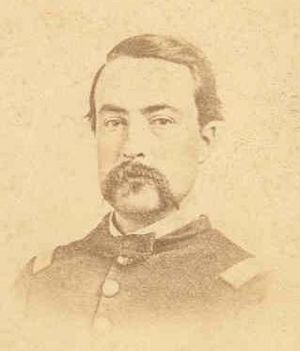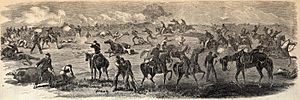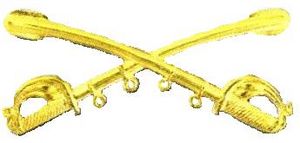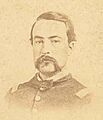Ira W. Claflin facts for kids
Quick facts for kids
Ira Wallace Claflin
|
|
|---|---|

Captain Ira W. Claflin
|
|
| Born | June 21, 1834 Rochester, Windsor County, Vermont |
| Died | November 18, 1867 (aged 33) Mount Pleasant, Texas |
| Buried |
Alexandria National Cemetery, Louisiana
|
| Allegiance | |
| Service/ |
|
| Years of service | 1857–1867 |
| Rank | |
| Commands held | 6th U.S. Cavalry Regiment |
| Battles/wars | American Civil War
|
Ira Wallace Claflin (June 21, 1834 – November 18, 1867) was an important officer in the United States Army. He graduated from West Point, a famous military school. During the American Civil War, he led the 6th US Cavalry during key moments, especially around the Battle of Gettysburg. Claflin also taught cavalry tactics and later became an instructor at West Point.
Early Life and Family
Ira Wallace Claflin was born on June 21, 1834, in Rochester, Vermont. He was the oldest of eight children born to Ira Claflin, Sr. and Hannah Wells Richardson.
On April 21, 1863, Ira W. Claflin married Jane Cooper Stuck in Hagerstown, Maryland. They had two children: a daughter named Mary Cooper Claflin and a son named Morris Fairfax Claflin. After Claflin's death, his father, Ira W. Claflin, Sr., helped raise his grandchildren and supported his daughter-in-law.
Military Career of Ira Claflin
Ira Claflin had a distinguished career in the United States Army. He served before, during, and after the American Civil War.
Joining the Army Before the War
In 1853, Claflin was appointed from Iowa to the United States Military Academy at West Point. He finished his studies and graduated on July 1, 1857. He was 27th in his class.
After graduating, he became a second lieutenant in the Regiment of Mounted Riflemen. From October 1857 to May 1858, he worked as an assistant instructor for cavalry. In June 1858, Claflin joined his regiment in Albuquerque, New Mexico, and served at Fort Union. He also took part in small actions against the Tuni-cha Navajos in 1859.
Serving in the American Civil War
When the American Civil War began, Claflin was ordered to join the new 3rd United States Cavalry. This unit was later renamed the 6th US Cavalry on August 3, 1861.
Claflin's reporting was delayed because he was needed elsewhere. He served with distinction at the Battle of Val Verde on February 21, 1862. For his brave service there, he was promoted to captain. He also fought at the Battle of Glorieta Pass on March 18, 1862, where he commanded an artillery unit. He then fought at Peralta, New Mexico, on April 15, 1862, before joining the 6th US Cavalry.
The Peninsula Campaign
Claflin, now a first lieutenant, was trained as an infantry soldier who could also ride a horse and scout. As a "horse soldier," he had years of experience on the frontier. His role was to be a professional soldier and set an example for his men. He also had to help his unit adapt to the new type of warfare in the East.
Early in the war, Union cavalry struggled against the Confederate cavalry. The 6th Cavalry had even chased J.E.B. Stuart's Cavalry, which rode completely around the Union Army in June 1862. This caused concern among Union commanders.
The Union Cavalry grew very quickly in the East, which led to some confusion. Many officers were chosen by their men or through politics, which sometimes meant they weren't the best leaders. Slowly, new tactics and strong leaders emerged. Union "horse soldiers" became skilled cavalry troopers. They learned to fight well both on horseback and on foot, using their carbines, pistols, and sabers. Claflin's experience helped his regiment adapt quickly.
He was at Yorktown from June to August 1862. He also fought in the Seven Days Battles (June 25 to July 1, 1862). He then served as the regiment's supply officer. In September, he was given command of several companies. His main job was to train, staff, and supply these companies so they could fight as cavalry. In April 1863, he took command of Company H of the 6th Cavalry. He stayed in this role, except when he was a staff officer.
The Gettysburg Campaign
The Gettysburg Campaign involved many battles and smaller fights before and after the main Battle of Gettysburg. Claflin played an important role in these events.
Here is how the Union Army was organized during this campaign:
- The Army of the Potomac was led by Major General Joseph Hooker, then by Major General George G. Meade starting June 28, 1863.
- The Cavalry Corps was commanded by Major General Alfred Pleasonton. It had divisions led by Brigadier Generals John Buford, David McM. Gregg, and H. Judson Kilpatrick.
The 6th US Cavalry Regiment was part of the First Division, Reserve Brigade. Claflin was a company commander and later took command of the regiment.
| Division | Brigade | Regiments and Others |
|---|---|---|
|
First Division: |
||
| Reserve Brigade: |
6th Pennsylvania Cavalry: Maj James H. Haseltine |
Claflin participated in these key battles and engagements in June and July 1863:
- Beverly Ford, Virginia, June 9, at the Battle of Brandy Station.
- Benton's Mill, Virginia, June 17.
- Middleburg, Virginia, June 21, at the Battle of Middleburg.
- Upperville, Virginia, June 21, at the Battle of Upperville.
- Fairfield, Pennsylvania, July 3, at the Battle of Fairfield.
- Williamsport, Maryland, July 6.
- Funkstown, Maryland, July 7.
- Boonesboro, Maryland, July 8 and 9, at the Battle of Boonesboro.
- Funkstown, Maryland, July 10, at the Battle of Funkstown.
Battle of Brandy Station
On June 9, 1863, Union and Confederate cavalry forces clashed at Brandy Station, Virginia. The Confederate cavalry, led by Major General J.E.B. Stuart, was surprised by a Union attack. The Union forces included the 6th U.S. Cavalry Regiment with Claflin.
Stuart's forces barely managed to push back the Union attack. This battle was the largest cavalry fight of the Civil War up to that point. It showed for the first time that Union cavalry, including officers like Claflin, were just as skilled as their Southern opponents.
Battle of Fairfield
On July 3, 1863, Union Brigadier General Wesley Merritt heard about a slow-moving Confederate wagon train near Fairfield, Pennsylvania. He ordered the 6th U.S. Cavalry, led by Major Samuel H. Starr, to find these wagons. This led to the Battle of Fairfield. Claflin was at the Cavalry headquarters as the regimental supply officer at this time.
Major Starr's 400 troopers dismounted and took defensive positions. They fought bravely against a mounted charge by the 7th Virginia Cavalry. The Confederates, supported by the 6th Virginia Cavalry, charged again. They pushed Starr's force off the ridge, causing heavy losses. Major Starr was wounded and captured.
Small groups of the 6th Cavalry regrouped several miles away, led by Lieutenant Louis H. Carpenter. They continued to harass the Virginia troopers, making it seem like a larger Union force was coming. After Major Starr's capture, Captain Claflin became the commanding officer of the regiment, with Lieutenant Carpenter as his executive officer.
The 6th Cavalry's stand at Fairfield was very brave. Even though they were heavily outnumbered and suffered many losses, they fought so well that the Confederates thought they were facing a much larger force. This delay prevented two Confederate brigades from causing serious problems in the Union's rear areas around Gettysburg. The regiment, now with only about 200 troopers and three officers, was commanded by Captain Claflin.
Funkstown, Maryland
On July 7, 1863, during a small battle at Funkstown, Maryland, Captain Claflin was seriously wounded in the shoulder. He had to leave the field and did not return to his regiment until September. For his brave and excellent service during the Gettysburg Campaign, Claflin was promoted to Brevet Major on July 7, 1863. His executive officer, Louis H. Carpenter, took temporary command until Claflin returned.
Overland Campaign
The 6th Regiment, now led by Claflin, became an escort unit for Major General Philip Sheridan. Sheridan was appointed to lead the Cavalry Corps of the Army of the Potomac in April 1864. Claflin's assistant, Carpenter, also worked closely with Sheridan's Cavalry Corps.
It is believed that Claflin and Carpenter influenced Sheridan's ideas about how to use Union cavalry more effectively. Sheridan wanted his cavalry to operate independently and conduct long-range raids.
On May 8, 1864, at the start of the Overland Campaign, Sheridan told Lieutenant General Ulysses S. Grant that if his Cavalry Corps could operate independently, he could defeat Confederate Major General J.E.B. Stuart. Stuart was the most famous and skilled Confederate cavalry officer. Grant was interested and allowed Sheridan to try.
The May 1864 Battle of Yellow Tavern was the first of four major raids. The others were Trevilian in June 1864, Wilson-Kautz in late June, and First Deep Bottom in July 1864. Only the Battle of Yellow Tavern was a clear Union victory. In this battle, "Jeb" Stuart was defeated and killed, which was a major blow to the Confederacy. The other raids mainly helped by distracting Confederate forces.
On November 11, 1864, Brevet Major Claflin was appointed as a special cavalry instructor. He taught cavalry tactics in the Department of West Virginia until July 21, 1865.
End of the Civil War
During the Civil War, Claflin served in at least 10 major campaigns and over 100 related battles. These included the 1861 Peninsula Campaign, the 1862 Maryland Campaign, the Campaign at Fredericksburg, the 1863 Gettysburg Campaign, and the Chancellorsville.
After the War and His Death
After the Civil War, Claflin served as an assistant instructor at West Point. He taught geography, history, and ethics until October 6, 1865. He then asked to be transferred back to his regiment, which was on occupation duty in Texas.
In Austin, Texas, Captain Claflin, back to his regular army rank, took command of H Troop. In June 1866, he led his troop on a three-month inspection tour of frontier posts. They covered almost 1,400 miles before returning to Austin.
On January 20, 1866, Claflin and Troop H were sent to Mount Pleasant, Texas. During a yellow fever epidemic, Captain Claflin became ill and died on November 18, 1867. He was only 33 years old. He left behind his wife, Jane Cooper (Stuck) Claflin, and two young children. His father, Ira W. Claflin, Sr., helped raise his grandchildren and supported his widow.
Ira W. Claflin, Captain, US Army, is buried in the Alexandria National Cemetery in Louisiana.
Honors and Awards
During his military career, Ira Claflin received several brevet promotions for his bravery and excellent service. He was mentioned in official reports many times during the Civil War.
| Major | Captain | First Lieutenant | 2nd lieutenant |
|---|---|---|---|
| O-4 | O-3 | O-2 | O-1 |
 |
 |
|
|
A monument at Gettysburg honors the regular soldiers of the United States Army who fought there, and it includes Claflin's name. United States Cavalry Reserve Brigade Brig. – General Wesley Merritt 1st. Regiment Captain Richard S.C. Lord Commanding 2nd. Regiment Captain Theophilus F. Rodenbough Commanding 5th. Regiment Captain Julius W. Mason Commanding 6th. Regiment Major Samuel H. Starr, Lieut. Louis H. Carpenter Lieut. Nicholas Nolan, Captain Ira W. Claflin Commanding
Images for kids







